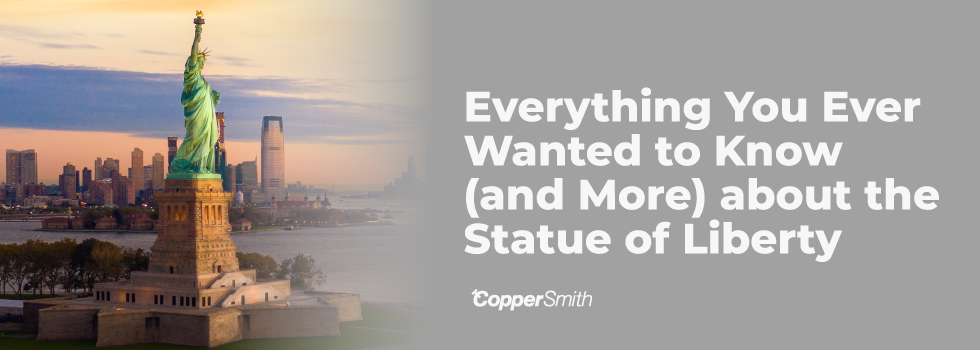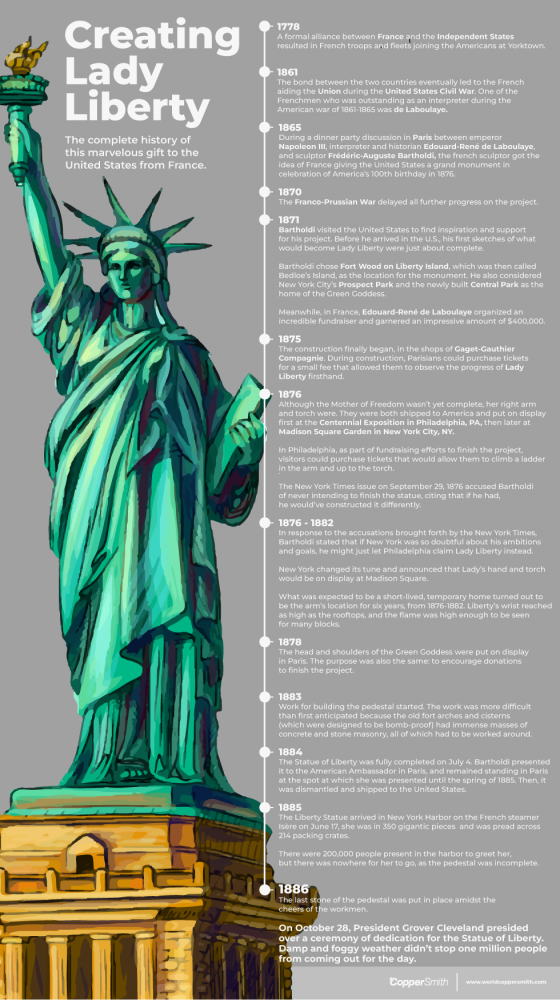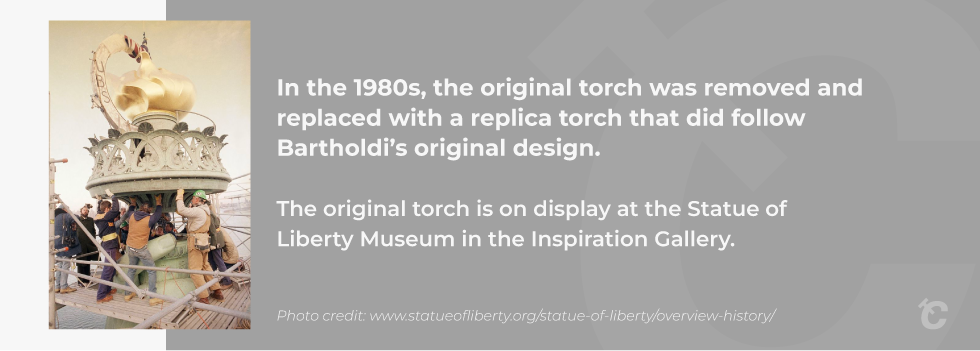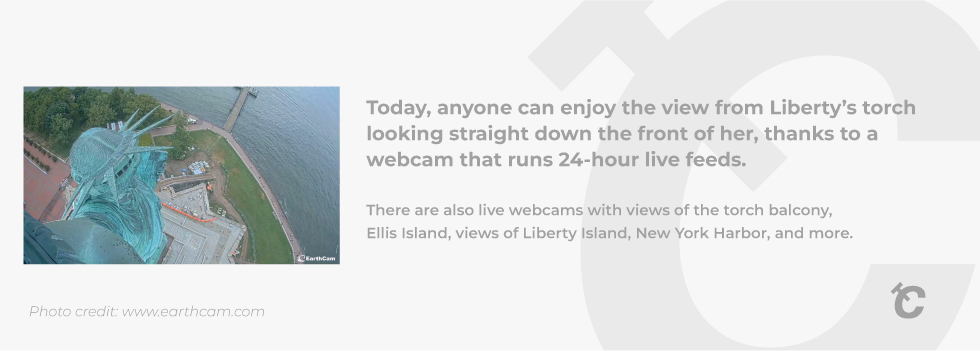
Lady Liberty is by far one of the most iconic and recognizable monuments in the world. Formally named “Liberty Enlightening the World,” the colossal Statue of Liberty continues to watch over the Upper New York Bay as she has done for the last 136 years.
While the statue itself is immediately recognizable, what is not so widely known is the complete history of this marvelous gift to the United States from France. There are many obscure facts surrounding this lady, and there are plenty of fascinating tales of what she represents, how she came to be, and what she has been through during her time on Liberty Island (and prior to it).
The Beginning: A Historian, an Emperor, and a Sculptor
A dinner party in Paris during the year 1865 would be the scene during which a group of Frenchmen discussed politics and the dictatorship of their emperor, Napoleon III (nephew of Napoleon Bonaparte). One of the Frenchmen was interpreter and historian Edouard-René de Laboulaye, and another was the French sculptor Frédéric-Auguste Bartholdi.
The discussion turned to the democratic government of the United States, which gave Bartholdi an idea. He wanted France to give the United States a grand monument in celebration of America’s 100th birthday in 1876. He had also hoped the sculpture might strengthen the democratic movement within France’s government.
He envisioned an enormous statue of a woman holding a torch that would light up the night with freedom’s light.
The gift would commemorate the friendship between France and the U.S. during the Revolutionary War, as well as the subsequent alliance of the two countries and their mutual dedication to freedom.

The Alliance between France and America
During the American Revolution, France supported the American colonists and supplied them with tactical advice, financial backing, and arms. They also sheltered colonial privateers. In 1778, a formal alliance between France and the independent states resulted in French troops and fleets joining the Americans at Yorktown.
This alliance remained strong, even through periods of political and social uprisings in France. The bond between the two countries eventually led to the French aiding the Union during the United States Civil War. One of the Frenchmen who was outstanding as an interpreter during the American war of 1861-1865 was de Laboulaye.
Hurry Up and Wait
If the colossal statue was going to be ready to present to the United States in time for the Centennial, there wasn’t a minute to lose.
However, the Franco-Prussian War (also known as the Franco-German War) raged from July 19, 1870, to May 10, 1871, which delayed all further progress on the project.
The French army had been defeated, and the strength of Germany was growing. Bartholdi, who was a native of Alsace, was overwhelmed with patriotism at this point because Alsace had been lost to Germany during this war.
The end of the war fueled the determination of both men to recommence progress on the monument with renewed fervor. More than ever, they wanted not only to present Liberty as a gesture of unity between the two countries but also to encourage a favorable attitude in America toward the French.
But Who Is Going to Pay for It?
Bartholdi soon got back to work on his idea and even visited the United States in 1871 to find inspiration and support for his project. Before he arrived in the U.S., his first sketches of what would become Lady Liberty were just about complete.
Bartholdi arrived in America by way of New York Harbor and was deeply moved by the vision he had of the allegorical statue watching over the waterway.
Bartholdi chose Fort Wood on Liberty Island, which was then called Bedloe’s Island, as the location for the monument (Bedloe's Island was renamed in 1956 by an act of Congress). However, he also considered New York City’s Prospect Park and the newly built Central Park as the home of the Green Goddess.
While Bartholdi could hardly contain his enthusiasm for his project, most Americans reportedly did not share his excitement, including President Ulysses S. Grant. Bartholdi returned to France, undeterred, with recommendations for the realization of the enormous project at hand.
Sentiment about the Liberty project gradually did improve in the U.S. Bartholdi refined his designs while Edouard-René de Laboulaye organized an incredible fundraiser in France. Impressively, $400,000 were garnered from the fundraising efforts.

A Considerably Late Start: Construction Begins
It took almost five years after Bartholdi visited the United States before construction began on Liberty Enlightening the World. He completed his original model in 1875, and the actual construction finally began.
Since the centennial of the United States was less than a year away at this point, the chances of the monument being all set for the celebrations were already nil. However, Bartholdi remained steadfast, as did everyone working on Lady Liberty’s construction.
The massive undertaking of turning Bartholdi’s model into an enormous monument began under his direct supervision in Paris, in the shops of Gaget-Gauthier Compagnie. During construction, Parisians could purchase tickets for a small fee that allowed them to observe the progress of Lady Liberty firsthand.
Lady Liberty’s Design Was Patented
On February 18, 1879, Bartholdi was granted U.S. Patent #11,023 for his monument, three years after he was originally officially commissioned to design Liberty. The patent read that it was for a “Design for a Statue.”
This type of patent excluded anyone else from using, making, or selling the design. This included replicating the design in pictures or in relief, like a statuette or statue. Replication was also banned using a variety of materials, including:
- Terracotta
- Plaster of Paris
- Metal
- Stone
- “Other plastic composition”
Interestingly enough, the very first handwritten application for Patent #11,023, dated January 7, 1879, shows that the words “right hand” were crossed out, and the words “left hand” were added. It’s unknown, however, whether it was Bartholdi who changed his mind and made that change or if it was a copyist’s mistake.
The patent would expire after 14 years. Along with sketches of the statue, Bartholdi included a description of his then-unfinished design with his patent application.
He described a statue of a female figure draped in cloth, with one arm supporting an inscribed tablet (inscribed with “July 4, 1776” in Roman numerals) and the other arm raised high, holding a torch. He also described a diadem upon her head (a diadem is a crown or headband that is worn to symbolize power and status).
Constructing Lady Liberty
The method used for the statue’s construction was a type of repoussé (metalwork). The original model made by Bartholdi was used as the starting point, which was about ten feet tall. Using the repoussé method, several successive layers of metal were added to the model until a figure 36 feet tall was formed.
Lath, Wood, and Copper
The 36’ tall statue was finished in plaster, and all of the contours and details were refined, then enlarged again. Forms were built out of lath, which supported multiple plaster sections molded to shape the statue. From these plaster sections, wooden patterns were fitted, then 350 sheets of copper were hammered and pressed to match the shapes of the wooden patterns.
These copper sheets formed the shell of the statue, with each one being 3/32” thick. They are held together by various types of joints. Each section of the statue is reinforced by iron bands that had been formed to match Lady Liberty’s contours. They are also connected to a central structure that resembles the design of a modern oil rig, or derrick.
The way the Lady was constructed makes her lightweight but strong at the same time, allowing her to withstand high winds and the elements. It also made it much easier to dismantle and transport.
The Link Between the Statue of Liberty, the Panama Canal, and the Eiffel Tower
The central tower, or framework, reportedly was designed by none other than Gustave Eiffel (this is up for debate), a French civil engineer whose crowning achievement is the Eiffel Tower. However, that wasn’t his only achievement.
Gustave Eiffel also supervised work on the railway bridge in Bordeaux, and he worked on the Porto Viaduct, the Pest Railway Station in Hungary, the Garabit Viaduct, the dome of the Nice Observatory, and several bridges throughout Europe. In fact, he built hundreds of various types of metal structures of all kinds, not just in Europe but all over the world.
Eiffel agreed to also build the Panama Canal locks in 1887, which was the biggest contract of his career. However, it was very poorly managed by a man named Ferdinand de Lesseps, and the project ended in an enormous financial scandal. De Lesseps’s mismanagement led to the folding of the construction company.
Because of all of this, Eiffel was indicted for fraud and sentenced to two years in prison, even though there was no evidence of him being personally responsible for any wrongdoing. The ruling was annulled later by the highest court of appeals, and he was liberated of all obligations concerning the charges.
He spent the next 30 years as a successful scientist who studied radio broadcasting, meteorology, and aerodynamics. He built a wind tunnel on rue Boileau in Paris in 1909, which is still in use.
Arguments over Where Liberty’s Home Would Be
The year 1876 approached, and although the Mother of Freedom wasn’t yet complete, her right arm and torch were. They were both shipped to America and put on display first at the Centennial Exposition in Philadelphia, PA, then later at Madison Square Garden in New York City, NY.
In Philadelphia, as part of fundraising efforts to finish the project, visitors could purchase tickets that would allow them to climb a ladder in the arm and up to the torch.
In October of 1877, New York joked that since Lady Liberty seemed to be coming to the U.S. in pieces, her legs should be displayed in Central Park or upside down in the middle of Central Park Lake.
Critics mockingly suggested that the other body parts of the statue be scattered throughout the city, stating that just about every public statue could be improved by being divided and distributed.
The New York Times Ignites a Rivalry
The New York Times issue on September 29, 1876, stated that the arm of the “French statue” and her hand were of such enormous proportions that her thumbnail was large enough to be a seat for the largest fat woman in existence.
The Centennial Exposition was concerned about the fate of the rest of the statue’s body, and the New York Times reported that the project had been suspended because of a lack of money. The newspaper also stated that Bartholdi chose the arm to come to America because it could still be a suitable standalone statue if the rest of Lady Liberty was never completed.
The publication proceeded to explain that a live woman without arms is without value, and so too is a bronze one. It accused Bartholdi of never intending to finish the statue, citing that if he had, he would’ve constructed it differently. It closes by stating that unless the United States funds its completion, it was doubtful that Liberty would ever be finished.
Bartholdi’s Response to The New York Times
In response to the accusations brought forth by the New York Times, Bartholdi stated that if New York was so doubtful about his ambitions and goals, he might just let Philadelphia claim Lady Liberty instead.
Just a couple of months after that response, New York changed its tune and announced that Lady’s hand and torch would be on display at Madison Square while the city awaited the rest of the statue.
Ground was broken in Madison Square near the Worth monument to make a temporary home for the arm of the statue. What was expected to be a short-lived, temporary home turned out to be the arm’s location for six years, from 1876-1882. Liberty’s wrist reached as high as the rooftops, and the flame was high enough to be seen for many blocks.
Liberty Also Nearly Went to Boston
When fundraising efforts to help with the construction stalled in New York, Boston made a play to become Liberty’s home. However, New York proved that nothing ignites its people like rivalry, so the city took to the New York Times with a stern warning to Boston.
New York continued to make it clear that it had changed its tune about Lady Liberty, stating in October of 1882 that no “third-rate town” was going to take the statue from them. It served as a warning to Boston that Philadelphia tried to “steal” it and failed, so Boston should back down.
New York also stated that the statue would be smashed into a million fragments before it ever ended up “stuck” in Boston Harbor.
The Mother of Freedom Atop the Washington Monument?
Rumor has it that there was also the possibility of Lady Liberty sitting atop the Washington Monument, which was 150 feet tall at the time.
The Washington Post said in March of 1883 that it was surprising how nicely the statue would’ve fitted the monument, and it seemed like it had been made for it.
Bedloe’s Island
The history of Bedloe’s Island is an eventful one. For centuries, Bedloe’s Island provided a major source of food for the Dutch settlers, and before that, the Lenape native people of the area. It was named after Isaac Bedloe, its first owner, who obtained it by a grant from the New York governor sometime before 1670.
Bedloe’s estate kept the island until 1732, then sold it. The city used it as a quarantine station during the 1740s, and a hospital was built upon it during the 1760s. In 1796, it was officially transferred from New York City to the state of New York.
The state worked together with the new federal government to build forts on Bedloe’s Island, Ellis Island, and Governor’s Island. The title to Bedloe’s was transferred from New York state to the United States. Construction began on the Bedloe’s Island fort in 1808 and was completed in 1811.
During the Civil War, the fort, known as Fort Wood, served as a recruiting station and depot. A small garrison remained on duty there until 1877, when Bartholdi chose it as the site for the Statue of Liberty.
The fort now serves as the base of the pedestal for the Statue of Liberty.
The Statue of Liberty on Display in Paris
The head and shoulders of the Green Goddess were put on display in Paris in a fashion similar to the display of the arm and torch in the U.S. The purpose was also the same: to encourage donations to finish the project.
However, the funds raised did not hit the goal Bartholdi needed until 1882. It took another two years before the Statue of Liberty was fully completed, and on July 4, 1884, Bartholdi presented it to the American Ambassador in Paris.
Lady Liberty remained standing in Paris at the spot at which she was presented until the spring of 1885. Then, it was dismantled and shipped to the United States. However, it would be another year before the pedestal on which she would stand would be completed.
Coming to America in Pieces
When Liberty arrived in New York Harbor on the French steamer Isère on June 17, 1885, she was still in pieces. Many, many pieces.
350 gigantic pieces, to be exact.
Those hundreds of pieces of the Statue of Liberty were spread across 214 packing crates. Included with the crates was an instruction manual detailing how to assemble the Green Goddess. There were 200,000 people present in the harbor to greet her, but there was nowhere for her to go, as the pedestal was incomplete.
But Where Is She Going to Stand?
Even though the statue itself was paid for by the French, the pedestal was the responsibility of the Americans. Ground for it was broken on April 18, 1883, but the work was more difficult than first anticipated. The old fort arches and cisterns (which were designed to be bomb-proof) had immense masses of concrete and stone masonry, all of which had to be worked around.
In addition, the American people were hesitant and slow to raise money for the construction of the pedestal. Lady Liberty was left in those unopened crates for several months. Eventually, the city of New York did pull the money together that was needed, with much credit going to an advertisement in March of 1885 by Joseph Pulitzer.
In the advertisement, Pulitzer announced that the names of every single person who donated any amount of money at all to the cause would have their names printed in his newspaper, New York World. The circulation of Pulitzer’s newspaper expanded by leaps and bounds as people bought copies just to see their names printed.
The clever marketing strategy rapidly produced results, finally accruing enough money for a grand pedestal to be built. In just five months, Pulitzer’s fundraising drive had garnered over $100,000 from 120,000 different donors.
Lady Liberty’s Pedestal
The pedestal on which the colossus now stands was designed by American architect Richard Morris Hunt and was constructed within the Fort Hood walls. Hunt went through several drafts, determined to design a pedestal that would complement the statue instead of overwhelming it.
Leete’s Island, Connecticut, was the supplier of granite for the outer wall of the pedestal, which would be backed by a massive sheet of concrete. The cornerstone of the pedestal was laid in August of 1884.
Shortly after, however, work stopped with only 15 feet of it having been completed. Money for the pedestal had run out, but thanks in big part to Pulitzer, financial resources came through, and work resumed in 1885.
When the pedestal reached the 29-feet-tall mark, four massive girders were built into the walls to form a square on the inside to help support the statue’s resistance to strong winds. At the 55-feet-tall mark, two sets of girders were installed and connected by iron beams that continued up for 60 feet above the pedestal.
The Statue of Liberty is actually a part of the pedestal now, with that 60 feet of iron beams serving as part of the statue’s framework. The pedestal rises 89 feet above its foundation and is so anchored down that it was once said that in order to overturn the Statue of Liberty, a wind storm would have to invert the whole island itself.
The last stone of the pedestal was put in place in April of 1886 amidst the cheers of the workmen, who reportedly tossed silver coins from their pockets into the mortar mix that was used.
Finally, the Mother of Freedom Is Reassembled
During the course of the next year, workmen endured challenging and dangerous conditions and complications that came along with rebuilding the massive monument in a harbor that was notoriously windy. The workers were unable to use traditional scaffolding due to the risk of it swinging and denting the softer metal of the statue.
Instead, the workers had to use more dangerous methods that included dangling from ropes and using pulleys, much like the systems window washers use. The iron framework was anchored to the steel beams rising from the pedestal, then sections of her “skin” were attached.
Originally, Bartholdi wanted to use floodlights in the torch to illuminate it, but there were concerns that ships passing the Statue of Liberty would be blinded. So Bartholdi had portholes cut in the gold-leaf–covered torch and had lights placed inside.
A power plant was built on the island, and the co-designer of Central Park and Prospect Park supervised a deep clean-up of the island. Although at first it was claimed that no one lost their life during reconstruction, it was later found that Francis Longo, a 39-year-old laborer, had perished when a wall fell on him.
The Dedication and Unveiling of Liberty Enlightening the World
On October 28, 1886, President Grover Cleveland presided over a ceremony of dedication for the Statue of Liberty. Damp and foggy weather didn’t stop one million people from coming out for the day. A parade in New York City was held, and then at 12:45 in the afternoon, a nautical parade began. President Cleveland took a yacht over to the island.
A French flag was draped over the face of Lady Liberty, which was supposed to be lowered to reveal the statue at the close of one of the speakers’ speeches. Bartholdi had ascended Liberty Enlightening the World, ready to lower the French flag.
However, he lowered it prematurely when the speaker paused during the speech, which Bartholdi thought was the speech’s end. The cheers of the crowd, whistles, applause, and guns ended the speech prematurely.
Not Everyone Loved Liberty
There were certain groups of people who objected to Lady Liberty or what she stood for. These groups included women suffragists and minorities, among others. Groups of women chartered boats and made speeches at the dedication, using the opportunity to advocate for women’s rights to vote.
These and other objectors also stated that Lady Liberty’s representation of the “freedom in America” was not true and that she more accurately represented the freedoms all Americans should have but still did not.
Liberty’s Torch
When Liberty’s torch was lit that night, it was so faint that it could hardly be seen. This was a problem because originally, the Statue of Liberty was meant to be a lighthouse in the harbor.
Many attempts were made to try to improve its brightness, but all proved ineffective. Lighting within the statue itself was improved, but the problem with the torch remained.
In 1892, an 18-inch belt of glass replaced the portholes that Bartholdi had added, and an 8-sided pyramidal skylight that had yellow, white, and red glass was installed upon the torch at the flame.
In 1916, the copper was removed in 250 areas of the torch and replaced with amber cathedral glass.
In 1931, a new lighting system was installed that required two 16” holes in the floor of the balcony that surrounds the flame. Two light projectors were installed through the holes, adding yet another revision to Bartholdi’s original torch design, which, by this point, was almost unrecognizable.
In the 1980s, the original torch was removed and replaced with a replica torch that did follow Bartholdi’s original design. The original torch is on display at the Statue of Liberty Museum in the Inspiration Gallery.

The Statue of Liberty Today: Opened and Closed
Although the Mother of Freedom no longer carries her original torch, her iconic symbolism remains the same. She has endured several periods of reconstruction and repairs over the years, including in 1939, 1983, 1984-86, and again in 2011-2012.
The Statue of Liberty was designated a national monument on October 15, 1924. The extensive restoration that was started in 1984 was completed by both American and French workers in time for her centennial on July 4, 1986.
Liberty Island was completely closed indefinitely immediately after the terrorist attacks on September 11, 2001. The island reopened in December of that year, but the colossal statue remained closed.
In 2003, a fundraising drive raised $5 million to upgrade emergency and fire systems and build additional exits. In 2004, a $20 million project to upgrade even more safety measures was executed. When completed, the Green Goddess reopened to the public.
In 2007, her crown was closed to visitors due to concerns about terrorism and fire safety. The crown reopened to visitors on July 4, 2009.
She was closed on October 29, 2011, for renovations and reopened on the 126th anniversary of her dedication on October 28, 2012.
However, the next day, Hurricane Sandy hit the Lady, causing extensive damage. After being reopened for just one day, she was closed once again until reopening on July 4, 2013.
In October of that same year, after being closed for almost two weeks due to the partial government shutdown, Lady Liberty was reopened, thanks to state funding.
On March 16, 2020, operations were suspended once again at the Statue and also on Ellis Island in response to the coronavirus pandemic outbreak. Liberty Island, along with the Statue of Liberty, reopened on August 29, 2020.

Did You Know? Fast Facts About the Statue of Liberty
Many people know some things about Lady Liberty, but there are many fascinating facts that are largely unknown:
- In 50 mph winds, Lady Liberty sways three inches, and her torch shifts five inches
- It’s estimated that 3.5 million people visit Lady Liberty each year.
- There are 354 steps to reach her crown
- The Lady herself is 151 feet, 1 inch tall — including her pedestal, she is 305 feet tall
- Her arm measures 46 feet, while her nose is almost five feet long, and her longest finger is eight feet long
- In 1906, Congress authorized over $62,000 to paint the statue because they thought the green patina was evidence of corrosion — public outcry against painting resulted in only the inside of her being painted
- The Statue of Liberty originally was envisioned as a lighthouse in the form of an Egyptian peasant in Muslim clothing at the entrance to the Suez Canal — Egypt rejected the idea because of its proposed cost
- Every year, the Lady is hit by lightning an average of 600 times
- At the close of WWII, her crown flashed a light that represented the letter “V” in Morse code, standing for “victory”
- Lady Liberty’s shoe size would be size 879
- The Statue of Liberty was modeled after the Roman Goddess of Freedom, Libertas
- The site was added to UNESCO’s World Heritage List in 1984
- With a 35-foot waistline, the statue weighs 225 tons (450,000 pounds)
On July 30, 1916, during the “Black Tom” explosions, German raiders set off an explosion close to Bedloe’s Island. Dynamite that was meant to head to France and Britain for the war effort was sabotaged and set off, and shrapnel damaged the torch-bearing right arm. The torch has been closed to the public ever since.
The Statue of Liberty is known by many other names, including:
- Liberty Enlightening the World
- The Green Goddess
- America’s Freedom
- Mother of Freedom
- Saint Liberty
- Lady on a Pedestal
There are also many discrepancies between different historians regarding the Mother of Freedom:
While some people claim that Bartholdi came up with the idea of a colossal statue for America, others state that it was actually Edouard de Laboulaye.
Although many people claim that the statue’s face was sculpted to resemble Bartholdi’s mother, Augusta Charlotte Bartholdi, others disagree.
Gustave Eiffel is credited with designing the inner framework of Lady Liberty, but the credit should actually go to Eugene Viollet-le-Duc, an architect first hired by Bartholdi — however, Viollet-le-Duc died in 1879, and Gustave Eiffel just revised his designs.
Many people claim that Lady Liberty’s 25 windows represent the minerals of the earth, but others say that’s nonsense.
Many people also claim that her seven spikes represent the seven seas and the seven continents, but the attraction’s official librarian states that that’s not true, saying that the spikes are sun rays and the circle is simply a nimbus (halo).
Some sources state that Bartholdi’s idea for Liberty was well-received by Americans, but others claim that Americans were not thrilled with the idea.
Some claim the broken chain and shackles around Liberty’s feet represent the arrival of immigrants, but others disagree, stating that it’s a reference to the abolition of slavery.
In addition, while some historical experts claim that women were not allowed at the dedication for fear that they would be injured with all of the excitement from the crowd, others claim that women did not attend in order to protest the fact that everyone was praising America’s freedoms, but women lacked true freedom.
France Recently Gave the United States Another Lady Liberty
In 2021, France sent over a bronze replica of the original Statue of Liberty to the United States for Independence Day, which was installed on Ellis Island for five days before being moved to Washington, D.C., where it will remain until 2031.
The nine-foot-tall replica, weighing 992 pounds, was given to the U.S. with the same goodwill as her older, much taller sister. She also traveled the same route that the original Statue of Liberty traveled.
French officials state that the friendship between France and the United States remains strong and is very important to them, just as it was 157 years ago when the idea for Lady Liberty first was envisioned during dinner.
Today, anyone can enjoy the view from Liberty’s torch looking straight down the front of her, thanks to a webcam that runs 24-hour live feeds. There are also live webcams with views of the torch balcony, Ellis Island, views of Liberty Island, New York Harbor, and more.
